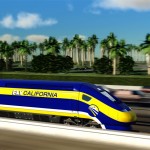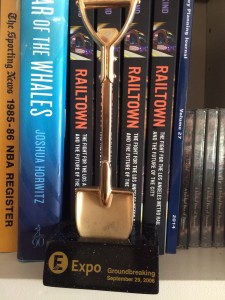
Governor Newsom’s “State of the State” speech today offered an abrupt scaling back of the state’s vision for its signature infrastructure project, high speed rail from Los Angeles to San Francisco:
[L]et’s level about high speed rail. I have nothing but respect for Governor Brown’s and Governor Schwarzenegger’s ambitious vision. I share it. And there’s no doubt that our state’s economy and quality of life depend on improving transportation. But let’s be real. The project, as currently planned, would cost too much and take too long. There’s been too little oversight and not enough transparency. Right now, there simply isn’t a path to get from Sacramento to San Diego, let alone from San Francisco to L.A. I wish there were. However, we do have the capacity to complete a high-speed rail link between Merced and Bakersfield.
In some ways, his position is a simple nod to fiscal reality. There aren’t enough funds right now to complete the project beyond this initial phase in the Central Valley anyway. Voters approved roughly $10 billion in bond funding in 2008, the 2009 federal “stimulus” bill offered another $3.5 billion, and Governor Brown and the legislature dedicated about 25% of cap-and-trade auction proceeds to continue building the system.
But that’s not enough to connect the Central Valley portion through the Pacheco Pass into San Jose, where it could then connect to the soon-to-be-electrified Caltrain into San Francisco. And it’s nowhere near the multiple billions of dollars needed to tunnel through the Tehachapi Mountains to connect to Southern California.
The key is the federal government: with Republicans in complete control of Congress from 2011 until last month, they were unwilling to match the state’s investment with federal dollars. While highway projects will get 90-100% funding from the federal government and intracity rail transit will get 50%, high speed rail has gotten just about 15% in federal matching funds — and only from that one-time 2009 stimulus grant.
If California had received closer to a 50% match from the federal government, the rail system would have the money to connect to the Bay Area. That link would provide significant economic benefits for Central Valley cities like Fresno and Merced by connecting them to the prosperous coastal economy. And it would create immediate benefits to bolster the long-term political support needed to eventually extend the system to Southern California.
But Governor Newsom’s speech today shows that he’s unlikely to spend much political capital to fight for these federal dollars from a congress that now features many California representatives, including the speaker, in control of the House of Representatives. It’s a position consistent with his 2014 interview in which he stated he would redirect funds from the system to other infrastructure needs.
Instead, his scaled-back vision presents a message that may confirm critics’ charges that the system is flawed and potentially infeasible. Some also worry that the new plan will embolden more litigants, arguing that the change in project vision violates the terms of that original 2008 bond initiative, although the courts have so far been deferential to state leaders on this question.
High speed rail backers will ultimately need a change in federal leadership come 2021 to get the necessary funds to complete the project — but it looks like they will have only tepid support from the state’s new governor in the meantime.
The groundbreaking ceremony for the just-opened Expo Line light rail to Santa Monica took place back on September 29, 2006. I was there and got this cool mini shovel memorabilia to honor the occasion:
That means that the opening of the full line to Santa Monica on Friday happened just under 10 years after groundbreaking. For those keeping score at home, that means the Expo Line Construction Authority managed to build 1.5 miles of rail each year.
As far as rail lines go, this should not have been a very complicated construction job. The line runs virtually entirely at-grade, with minimal trenching and a handfull of overpasses. In addition, the right-of-way already existed and therefore required relatively little property acquisition and condemnation.
In short, the amount of time spent to build this line seems absurd. That’s not even counting the years of planning. And yet the region’s leaders apparently aren’t upset by it or demand any better.
Sadly, at this point, Californians have just gotten used to these interminable construction timetables. High speed rail is way behind schedule and won’t open until probably the 2040s or 2050s, if at all. The Purple Line subway extension down Wilshire most likely won’t be operational until the 2030s. Even automobile projects like the San Francisco Bay Bridge eastern span took over a decade to open.
It’s a subject I tackled for UCLA Law in 2014, with the report Back in the Fast Lane, and an op-ed in the San Francisco Chronicle. Yet I’ve seen little interest among policy makers (or even the public) to tackle this issue. Why the complacency?
For those who care about boosting transit, they have an interest in getting ahead of this problem. A few bad headlines can undermine political support for transit investments, especially in California where advocates need two-thirds voter approval for tax measures. And it also means we’re getting much less bang for our buck on these projects, which means fewer projects that benefit people.
It’s enough to make me mad. Or maybe it will later. At some point anyway.
Caltrans announced the groundbreaking of a $38 million rail project that will add 3.8 additional miles of track to the Los Angeles area, vastly improving Amtrak service between San Diego, Los Angeles and San Luis Obispo.
The “Triple Track Project” is fully-funded from stimulus dollars (remember those?) as part of a larger $163 million, 15-mile main line track expansion between the cities of Commerce and Fullerton in Southern California. The project will lay an additional third track next to the two existing lines.
For all the hype about high speed rail, improvements to our existing Amtrak service like these are much cheaper and faster to build. It’s not an excuse not to do high speed rail necessarily, but these investments will still be necessary, given the limited route, long time horizons, and expense of building high speed rail.



